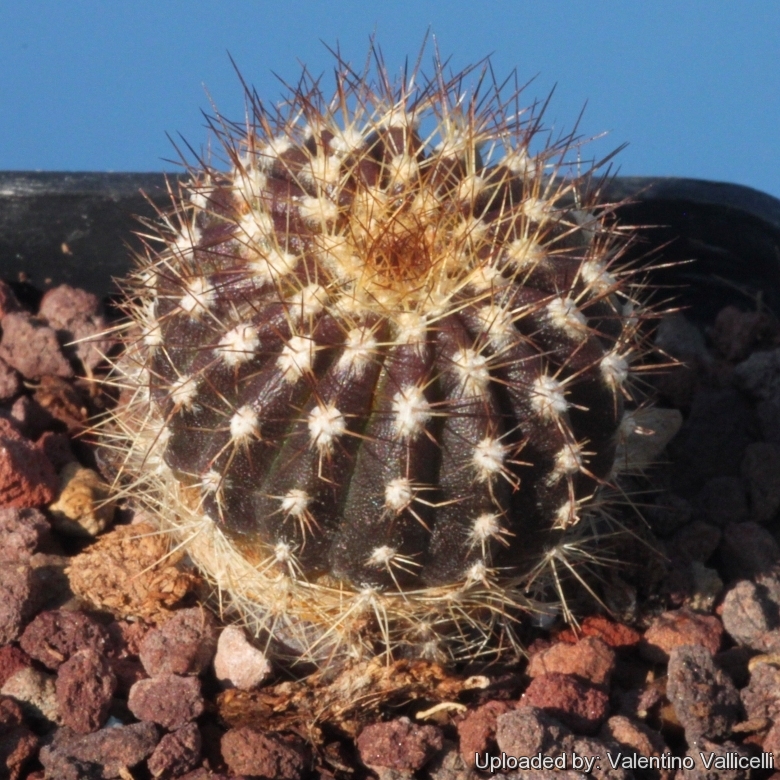Accepted Scientific Name: Uebelmannia pectinifera subs. flavispina (Buining & Bredero) P.J.Braun & Esteves
Succulenta (Netherlands) 74(3): 135 (1995)

Uebelmannia pectinifera subs. flavispina var. longispina Photo by: Valentino Vallicelli
Origin and Habitat: Uebelmannia pectiniferaSN|14312]]SN|14312]] ssp. flavispina v. longispina (Field number: HU 856) is found at Guinda, Minas Gerais, Brazil just a few km from the habitat of Uebelmannia pectiniferaSN|14312]]SN|14312]] ssp. flavispina at West of Diamantina, Barao de Quacui, Minas Gerais, Brazil (Field number: HU 361).
Synonyms:
See all synonyms of Uebelmannia pectinifera
Description: Uebelmannia pectiniferaSN|14312]]SN|14312]] ssp. flavispina v. longispina n.n. is an undescribed name used commercially to indicate one of the local forms or varieties of Uebelmannia pectiniferaSN|14312]]SN|14312]] ssp. flavispina, which is a solitary cactus globular or slightly elongated up to 50 cm tall and 10-15 cm wide, with closely set amber yellow spines, neatly arranged, straight, that give a comb-like effect. The morphological or geographical form labelled Uebelmannia pectiniferaSN|14312]]SN|14312]] ssp. flavispina v. longispina is distinguished longer and thicker spines. It has been found by the commercial collector Leopoldo Horst in 1988 who spread it under no. HU 856. Uebelmannia pectiniferaSN|14312]]SN|14312]] ssp. flavispina v. longispina should be included within (as a synonym of) Uebelmannia pectiniferaSN|14312]]SN|14312]] ssp. flavispina, suggesting that there is not really a fundamental difference between the two.
Subspecies, varieties, forms and cultivars of plants belonging to the Uebelmannia pectinifera complex
 Uebelmannia pectinifera Buining: (ssp. pectinifera) It has about 18 ribs and slowly grow up to 50 cm in height. Origin: It comes from the mountains in the higher part of the areal.
Uebelmannia pectinifera Buining: (ssp. pectinifera) It has about 18 ribs and slowly grow up to 50 cm in height. Origin: It comes from the mountains in the higher part of the areal. Uebelmannia pectinifera var. crebispina n.n.: Barao de Quacuy, Minas Gerais, Brazil.
Uebelmannia pectinifera var. crebispina n.n.: Barao de Quacuy, Minas Gerais, Brazil. Uebelmannia pectinifera var. eriocactoides Řepka, Krajča & V.Toman: The seedlings closely resemble to juvenile plants of Eriocactus leninghausii, hence the name.
Uebelmannia pectinifera var. eriocactoides Řepka, Krajča & V.Toman: The seedlings closely resemble to juvenile plants of Eriocactus leninghausii, hence the name. Uebelmannia pectinifera subs. flavispina (Buining & Bredero) P.J.Braun & Esteves: It has up to 29 ribs with amber yellow spines, and can grow about 35 cm tall. Origin: west of Diamantina.
Uebelmannia pectinifera subs. flavispina (Buining & Bredero) P.J.Braun & Esteves: It has up to 29 ribs with amber yellow spines, and can grow about 35 cm tall. Origin: west of Diamantina. Uebelmannia pectinifera subs. flavispina var. longispina n.n.: like subsp. flavispina, but spines longer and thicker. Distribution: Guinda, Minas Gerais, Brazil.
Uebelmannia pectinifera subs. flavispina var. longispina n.n.: like subsp. flavispina, but spines longer and thicker. Distribution: Guinda, Minas Gerais, Brazil. Uebelmannia pectinifera subs. horrida (P.J.Braun) P.J.Braun & Esteves: Stem with more than 23 ribs (up to 40) it is the taller of the three and can reach 1 m of height. Origin: Serra do Espihaço.
Uebelmannia pectinifera subs. horrida (P.J.Braun) P.J.Braun & Esteves: Stem with more than 23 ribs (up to 40) it is the taller of the three and can reach 1 m of height. Origin: Serra do Espihaço. Uebelmannia pectinifera var. multicostata Buining & Bredero: has 20 or more ribs. Distribution: 10 km E of Mendanha towards the Rio Jequitinhonha, Minas Gerais, Brazil.
Uebelmannia pectinifera var. multicostata Buining & Bredero: has 20 or more ribs. Distribution: 10 km E of Mendanha towards the Rio Jequitinhonha, Minas Gerais, Brazil. Uebelmannia pectinifera var. pseudopectinifera Buining: has smaller and greener stems, with separate (not confluent) areoles without brush-like spines. Distribution: Diamantina, Minas Gerais, Brazil.
Uebelmannia pectinifera var. pseudopectinifera Buining: has smaller and greener stems, with separate (not confluent) areoles without brush-like spines. Distribution: Diamantina, Minas Gerais, Brazil. Uebelmannia pectinifera f. variegata hort.
Uebelmannia pectinifera f. variegata hort.
Cultivation and Propagation: This tropical cactus loves warm moist, humid conditions and mist spraying is a must in summer. Water regularly during the growing season and use a very draining mineral potting substrate. At the onset of winter, do not water. Uebelmannias need heat all year round and extra winter heat, minimum 10C is best. Avoid any frost. Keep cool in summer. This plant prove to be root prone if kept too cold in winter. To help stop this, a good deep collar of pumice or lava grit is an excellent idea. It prefers a position in full sun, and possibly afternoon shade in summer. If you can place it so that this occurs, the plant will be much happier.
Propagation: Seeds, but plants are often grafted, making them easier to grow, particularly through the winter. If possible using a rootstock that is more hardy than the Uebelmannia is ideal.










